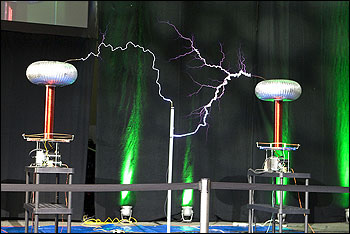
NIWeek 2010: A Shocking Show
by Hank Hogan
Austin, Texas, Aug. 6, 2010 — The audience stirred when indoor lightning was first mentioned. They sat forward and craned for a look when the bolts started flying and the music began, courtesy of a setup from ArcAttack.
As the pair of Tesla coils sang, a sensor between the two measured the temperature generated by the artificial lightning. After the light and music show was over, Philip Wong and Stuart Gillen, members of a research and development team at National Instruments, explained that the company’s new optical sensor interrogator and fiber Bragg grating optical sensors supplied by other vendors made the measurements.
When asked why NI was getting into the optical sensor business now with an announcement at the show, Gillen, a group manager, said, “The technology hadn’t matured until now.”

Music produced via Tesla coil arcs, with optical fiber temperature sensing. (Image: National Instruments)
The musical Tesla coil demonstration, part of the NIWeek 2010, wowed the standing room audience, which looked to be a good chunk of the 3000 or so registered attendees of the annual user’s conference and trade show. As in the past, the show was held in early August.
That attendance figure, company officials said, is up significantly from last year. It rivals, and is perhaps greater than, the attendance of two years ago, which is perhaps a better yardstick to gauge the show’s success. Final attendance figures won’t be available for some time.
On the show floor, Paulo Martins welcomed NI’s entry into the optical sensing market as part of his response to a question hours after the demonstration. At first, that might seem a bit surprising. Martins is in software development for FiberSensing - Sistemas Avançados de Monitorização, S.A, a Maia, Portugal based company that makes advanced monitoring systems based on fiber Bragg grating technology.
He explained, though, that the new player would add legitimacy to the market and help dispel misinformation circulating about the technology. The warm welcome is also probably due to the fact that FiberSensing, which had a booth at the show, makes sensors, the piece of the solution that NI isn’t manufacturing.
This optical sensor technology runs from about 1500 to 1600 nm wavelength. A single fiber and interrogator can service different sensors through wavelength multiplexing. That is, each sensor will be set up at a different wavelength and they can then be interrogated individually.
There were some other aspects of the show with a distinct photonics flavor. In a keynote devoted to machine vision, the advice was to divide and conquer. Nigel Holmes, vision systems development manager at Southfield, Mich.-based Tier 1 automotive supplier Federal-Mogul, went through a history of efforts to automate inspection at the company’s factories.
Although he couldn’t go into specifics, a distributed inspection generally approach works best, he said. “It lets us find defects almost immediately.”
He did acknowledge that justifying this approach can be difficult, since at first it seems to be all expense and no savings. However, with proper accounting of the cost of scrap arising from manual inspection, the balance sheet looks much better, perhaps good enough to get a project go-ahead from management.
Machine vision was also at the heart of one exhibit on solar cell inspection. Kamalina Srikant, a product marketing engineer at NI, said that this involved running the solar cell in reverse. The test put electrons in, causing the photovoltaic material to produce photons. A camera then studied the light output, pinpointing problems.
A different type of vision, the human kind, was behind another demonstration. Alfamation S.p.A. of Lissone, Italy makes a video analyzer for high-definition and 3D TV. Today, said company president and CEO Mauro Arigossi, most TVs are just checked out visually. The company’s new product will run a complete test of all input modes for these TVs in 10 seconds or less.
The technology of 3D may be well underway in terms of development but the art of producing films and content is still being worked out, said Arigossi. “The interpretation of 3D is now at an early stage.”
One theme was present in the background of all the exhibitions, demonstrations, and talks given at the conference. That was evident in the lanyard holding the badges given to all attendees. These were adorned with the name and logo of Intel, a company that has pushed semiconductor technology in its pursuit of Moore’s Law. This doubling of the number of transistors on a chip makes possible all of the advances seen at NIWeek.
As NI cofounder, president and CEO James Truchard said in his keynote, “Moore’s Law has been the wind behind out backs.”
Hank Hogan
[email protected]
/Buyers_Guide/National_Instruments_Corp/c10059